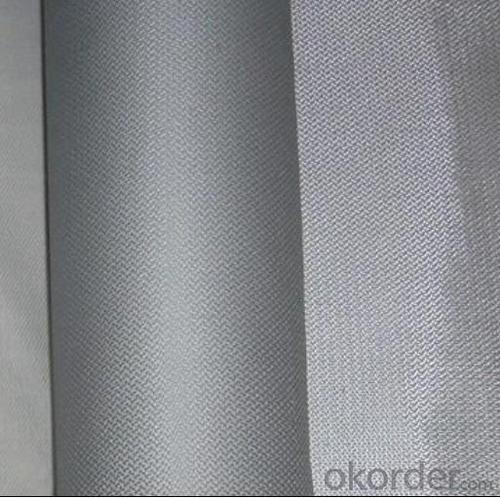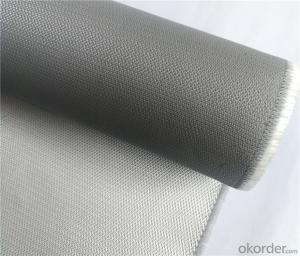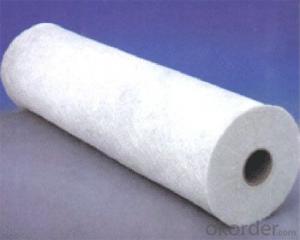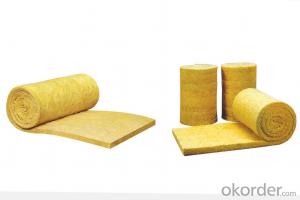Glass Fiber Textiles - PU Coated Fiberglass Fabric
- Loading Port:
- China Main Port
- Payment Terms:
- TT or L/C
- Min Order Qty:
- 10 Tons kg
- Supply Capability:
- 2*20FCL Per Month kg/month
OKorder Service Pledge
OKorder Financial Service
You Might Also Like
General Information of PU Coated Fiberglass Fabric
PU Coated Fiberglass Fabric is a fiberglass cloth coated with Polyurethane, and composite materials with multiple functions, the design of PU coated fiberglass fabric can adapt to different places.
It features good rebound resilience, toughness, softness, bright in color, superior resistance to wear, cold, oil, water, aging and weather. It also has the function of an antibacterium, and can also be used for mould proofing, heat-insulation and anti-ultraviolet.
Can be used for waterproofing in roof, underground projects, bridges, drainage channels, reservoir and disposal of sewage and etc, also applied to motor, chemical plant, equipment of power plant and so on.
Basic Info of PU Coated Fiberglass Fabric
Model NO.:CMAX-FF004
Type:Fiberglass Mesh
Function:Fireproof
Export Markets:Global
Additional Info of PU Coated Fiberglass Fabric
Trademark:CMAX
Packing:Plastic Bag+Carton+Pallet
Standard:ISO9001-2000
Origin:Jiang Su
HS Code:70193900
Production Capacity:2000000m2 Per Month


- Q: Can glass fiber textiles be used for geotextiles?
- Yes, glass fiber textiles can be used for geotextiles. Geotextiles are synthetic materials that are used in civil engineering applications to enhance soil stability, provide drainage, and prevent erosion. Glass fiber textiles offer several advantages that make them suitable for geotextile applications. Firstly, glass fiber textiles have high tensile strength, which means they can withstand heavy loads and provide reinforcement to the soil. This is especially important in applications such as road construction, where the geotextile needs to provide structural support. Secondly, glass fiber textiles are highly resistant to chemical and biological degradation. This makes them ideal for geotextile applications in areas where the soil is exposed to harsh environmental conditions, such as chemical spills or high levels of acidity. Furthermore, glass fiber textiles have excellent dimensional stability, meaning they do not shrink or expand significantly under different temperature and moisture conditions. This property ensures that the geotextile maintains its integrity and effectiveness over time. Lastly, glass fiber textiles have a low coefficient of thermal expansion, which means they do not expand or contract significantly with temperature changes. This property is crucial in geotextile applications where the material needs to remain stable and not cause any damage to the surrounding structures. In conclusion, glass fiber textiles can indeed be used for geotextiles due to their high tensile strength, resistance to degradation, dimensional stability, and low coefficient of thermal expansion. These properties make them a reliable and durable choice for various civil engineering applications.
- Q: How are glass fiber textiles used in the electronics industry?
- The electronics industry extensively utilizes glass fiber textiles for various purposes. Insulation is one of the main applications of these textiles. Due to their exceptional resistance to heat and excellent electrical insulation properties, they are ideal for creating protective barriers around sensitive electronic components. This insulation helps prevent heat transfer and electrical short circuits, ensuring the safe operation of electronic devices. Another use of glass fiber textiles is in the manufacturing of printed circuit boards (PCBs). PCBs act as the backbone of electronic devices, facilitating the necessary connections between different components. Glass fiber textiles, specifically epoxy glass laminates, serve as the base material for PCBs. These textiles are impregnated with epoxy resin and layered with copper sheets, resulting in a strong and durable substrate for the circuitry. Furthermore, glass fiber textiles are employed to reinforce electronic components. By incorporating glass fibers into the manufacturing process of connectors, switches, and housings, the overall strength and structural integrity of these components are enhanced. This reinforcement allows for better resistance against mechanical stress, such as impacts or vibrations, ensuring the longevity and reliability of electronic devices. Additionally, glass fiber textiles have applications in electromagnetic shielding. They can be woven into conductive fabrics, which are used to create shielding enclosures or covers for electronic devices. This shielding prevents electromagnetic interference (EMI) and radio frequency interference (RFI) from affecting the performance of sensitive electronic circuits. By effectively blocking these interferences, glass fiber textiles contribute to maintaining the quality of signal transmission and reception in electronic devices. Overall, glass fiber textiles play a crucial role in the electronics industry by providing insulation, serving as PCB substrates, reinforcing electronic components, and contributing to electromagnetic shielding. Their thermal and electrical insulation properties, combined with their strength and durability, make them an essential material for ensuring the proper functioning and protection of electronic devices.
- Q: What are the advantages of glass fiber textiles?
- Glass fiber textiles are a popular choice in various industries due to their numerous advantages. Firstly, they possess exceptional strength and durability, boasting high tensile strength that enables them to withstand significant tension without breaking or deforming. This quality makes them ideal for reinforcing concrete structures in the construction industry, where strong and long-lasting materials are essential. Secondly, glass fiber textiles exhibit excellent heat resistance, allowing them to endure high temperatures without melting or compromising their structural integrity. This makes them suitable for applications such as fire-resistant clothing, insulation materials, and even thermal protection in the aerospace industry. Additionally, glass fiber textiles are highly resistant to chemicals and corrosion. They do not react with most chemicals, acids, or alkalis, making them suitable for use in harsh environments or in contact with corrosive substances. This corrosion resistance makes them ideal for industries like oil and gas, chemical processing, and marine applications. Furthermore, glass fiber textiles possess low electrical conductivity, which makes them suitable for use in electrical insulation materials. They prevent the flow of electric current and minimize the risk of electrical shock or short circuits. Another advantage is the lightweight nature of glass fiber textiles. They offer great strength and durability while being relatively lightweight, thanks to their high strength-to-weight ratio. This makes them easier to handle and transport, reducing costs and improving efficiency in manufacturing processes. Lastly, glass fiber textiles are non-combustible, meaning they do not easily catch fire or support combustion. This characteristic makes them a safer choice for applications where fire resistance is crucial, such as building materials, automotive parts, and protective clothing. Overall, the advantages of glass fiber textiles encompass their strength, durability, heat resistance, chemical resistance, electrical insulation properties, lightweight nature, and non-combustibility. These qualities make them a versatile material with applications in various industries, ensuring optimal performance in demanding environments.
- Q: Can glass fiber textiles be used for making sporting goods or equipment?
- Yes, glass fiber textiles can be used for making sporting goods or equipment. Glass fibers are strong, lightweight, and have excellent resistance to heat and chemicals, making them suitable for various sporting applications. They can be used to reinforce composite materials in items such as tennis rackets, hockey sticks, or even protective gear like helmets.
- Q: What are the different finishes available for glass fiber textiles?
- Glass fiber textiles offer a range of finishes, each with its own unique properties and applications. Let's explore some of the most common finishes available: 1. Sizing: This finish enhances the handling and processing characteristics of glass fiber textiles. By reducing fiber-to-fiber friction, it facilitates easier handling and weaving. Additionally, sizing temporarily shields the textile from abrasion and mechanical damage during processing. 2. Silane Finish: Silane, a commonly used chemical compound, acts as a finish for glass fiber textiles. It improves adhesion between the glass fibers and the matrix material in composite applications. Furthermore, silane finishes enhance the wetting properties of the fibers, allowing for better resin impregnation during composite processing. 3. Anti-static Finish: Glass fiber textiles can be treated with an anti-static finish to prevent the accumulation of static electricity. This is particularly valuable in applications where static electricity can cause issues, such as in the manufacturing of electronic components or in cleanrooms. 4. Fire-resistant Finish: To enhance their resistance to flame and heat, glass fiber textiles can be treated with fire-resistant finishes. These finishes offer added safety in applications where fire hazards are present, such as in the construction industry or in protective clothing. 5. Water-repellent Finish: Applying a water-repellent finish to glass fiber textiles makes them resistant to water absorption. This prevents the textile from becoming heavy and wet, thereby preserving its performance and durability. 6. UV-resistant Finish: By treating glass fiber textiles with UV-resistant finishes, they can be shielded from the harmful effects of sunlight. These finishes protect the fibers from degradation and extend the textile's lifespan, making it suitable for outdoor applications. It is worth noting that different finishes can be combined to meet specific performance requirements. For instance, a glass fiber textile may feature both a silane finish for improved adhesion in composite applications and a fire-resistant finish for heightened safety. The choice of finish depends on the intended application and the desired properties of the textile.
- Q: Can glass fiber textile be used in wind turbines?
- Yes, glass fiber textile can be used in wind turbines. Glass fiber textile, also known as fiberglass, is a versatile material that offers several advantages for wind turbine applications. It is lightweight, strong, corrosion-resistant, and has excellent fatigue properties, making it an ideal choice for manufacturing wind turbine blades. The use of glass fiber textile in wind turbine blades helps to enhance their performance and efficiency. The material's high strength-to-weight ratio allows for longer and lighter blades, enabling greater energy capture from the wind. Additionally, its corrosion-resistant properties make the blades more durable and resistant to environmental degradation, resulting in reduced maintenance and replacement costs. Furthermore, glass fiber textile can be easily molded into complex shapes, allowing for the design of aerodynamically efficient blade profiles. This flexibility in manufacturing enables the production of customized blade designs that optimize energy generation and reduce noise generation. In conclusion, glass fiber textile is a suitable material for wind turbines due to its lightweight, strength, corrosion resistance, and flexibility in manufacturing. Its use in wind turbine blades contributes to improved performance, efficiency, and longevity of the turbines.
- Q: Is glass fiber textile fire-resistant?
- Yes, glass fiber textile is fire-resistant. Glass fiber textiles are made from woven or non-woven glass fibers, which have a high resistance to heat and flames. They do not ignite easily and are able to withstand high temperatures without melting or releasing toxic fumes. Glass fiber textiles are commonly used in applications where fire safety is a concern, such as in the production of fire-resistant clothing, curtains, upholstery, and insulation materials.
- Q: Can glass fiber textiles be treated with flame retardants?
- Yes, glass fiber textiles can be treated with flame retardants.
- Q: Can glass fiber textiles be used in the aerospace industry?
- Yes, glass fiber textiles can be used in the aerospace industry. They possess excellent strength-to-weight ratio, high temperature resistance, and good electrical insulation properties, making them suitable for various applications in aerospace, such as composite structures, insulation, and protective covers.
- Q: Are glass fiber textiles suitable for marine applications?
- Yes, glass fiber textiles are suitable for marine applications. Glass fiber textiles, also known as fiberglass textiles, have several properties that make them ideal for use in marine environments. Firstly, glass fiber textiles are highly resistant to corrosion. This is a critical feature when considering materials for marine applications, as they are constantly exposed to saltwater, which can cause corrosion and deterioration of many other materials. Glass fiber textiles, however, do not rust or corrode, making them highly durable in marine environments. Additionally, glass fiber textiles have excellent strength-to-weight ratio. This means that they offer high strength and structural integrity while being lightweight. This is particularly important for marine applications as it allows for the construction of strong and durable structures without adding excessive weight to the vessel or equipment. Glass fiber textiles also have good dimensional stability, meaning they can maintain their shape and size even when exposed to fluctuating temperatures and humidity levels. This is crucial for marine applications, as vessels and equipment are often subjected to varying environmental conditions. Furthermore, glass fiber textiles are non-conductive and have good electrical insulation properties. This makes them suitable for marine applications where electrical components and wiring need to be protected from water and moisture. Lastly, glass fiber textiles are relatively easy to mold and shape, allowing for flexibility in design and construction. This versatility makes them suitable for various marine applications, ranging from boat hulls and decks to insulation and protective covers. Overall, glass fiber textiles offer a range of favorable properties that make them highly suitable for marine applications. Their resistance to corrosion, strength-to-weight ratio, dimensional stability, electrical insulation properties, and flexibility in design make them a reliable choice for various marine structures and equipment.
Send your message to us
Glass Fiber Textiles - PU Coated Fiberglass Fabric
- Loading Port:
- China Main Port
- Payment Terms:
- TT or L/C
- Min Order Qty:
- 10 Tons kg
- Supply Capability:
- 2*20FCL Per Month kg/month
OKorder Service Pledge
OKorder Financial Service
Similar products
Hot products
Hot Searches
Related keywords




























